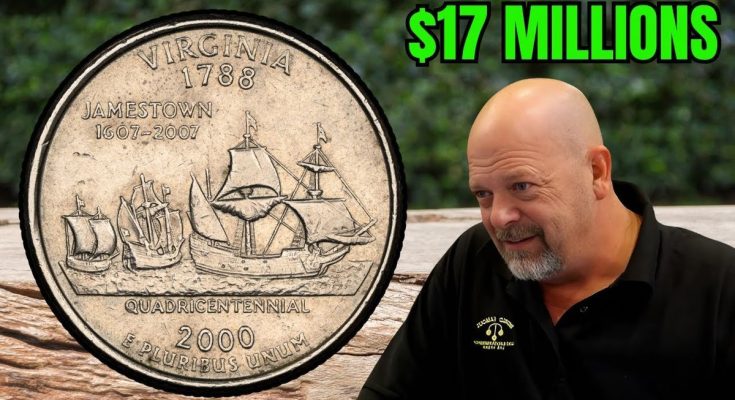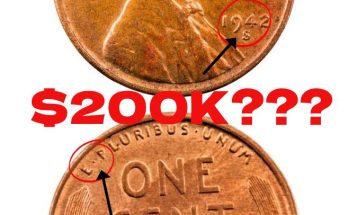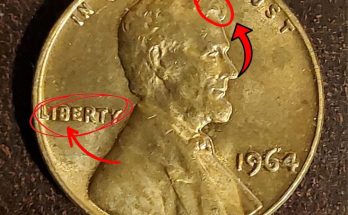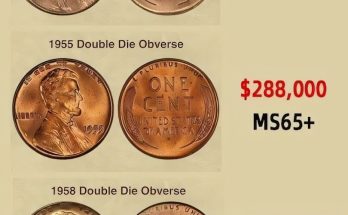DO YOU HAVE U.S. STATE QUARTER DOLLAR COINS THAT COULD MAKE YOU A MILLIONAIRE?
Have you ever looked at the State Quarters in your pocket change and wondered if any of them are worth more than 25 cents? Most people assume these coins are just modern circulation pieces with no real value to collectors. But they couldn’t be more wrong. While the vast majority of State Quarters are indeed worth face value, a select few—due to rare minting errors or their impeccable, a-class condition—are worth hundreds, thousands, or even tens of thousands of dollars. In this video, we’re going to dive into the exciting world of these modern treasures and show you exactly what to look for.
The U.S. Mint’s 50 State Quarters Program, which ran from 1999 to 2008, was a massive undertaking that produced billions of quarters. With so many coins being struck, it was inevitable that a small number of errors would slip through quality control and find their way into circulation. These “freaks of the mint” are the holy grail for collectors, and their scarcity drives their value through the roof.
We’ll start with the coin you see on screen, the 2000 Virginia quarter. While most of the 1.6 billion Virginia quarters produced are worth a quarter, a few have sold for thousands of dollars. This is often due to rare minting errors like a missing clad layer, which can dramatically alter the coin’s appearance and value. But it’s not just the Virginia quarter you need to check. Across the entire series, from the first Delaware quarter to the last Hawaii quarter, there are valuable errors waiting to be found.
Here are some of the most shocking and valuable State Quarters you should be looking for right now:
- The 2004-D Wisconsin “Extra Leaf” Quarter: This is one of the most famous error coins of the State Quarter series. It features a distinct die gouge on the reverse, creating the appearance of an extra leaf on the corn stalk. There are two varieties—the “Extra Leaf High” and the “Extra Leaf Low”—that can be worth up to $6,000 in top grades. We’ll show you a close-up of both so you know what to look for.
- The 2005-P Minnesota “Extra Tree” Quarter: Another fantastic doubled die error, this coin shows distinct doubling on the trees on the coin’s reverse, giving it the appearance of an extra tree. High-grade examples of this error have sold for thousands of dollars.
- The 1999-P Delaware “Spitting Horse” Quarter: This is a truly unique and famous error. A small die break on the obverse extends from the horse’s mouth, making it look as though it’s spitting. This whimsical and rare error has made these coins highly desirable, with some examples selling for hundreds of dollars.
- The 2000-P South Carolina Quarter in MS69: While many valuable State Quarters are errors, some are simply valuable because of their impeccable condition. A pristine, flawless coin—graded MS69 by a professional service—is incredibly rare for any circulating coin. Only a tiny fraction of the billions of coins produced make it to this grade. A 2000-P South Carolina quarter with this grade has sold at auction for over $8,000, proving that a coin’s condition can be its most valuable asset.
This video is your complete guide to identifying these numismatic treasures. We’ll give you actionable tips on how to inspect your coins, the best tools to use, and how to spot the difference between a minor blemish and a genuine, valuable error. We’ll also explain the importance of professional coin grading and what to do if you think you’ve found a rare coin.
The next time you’re at the bank or sorting through your change, don’t just put those State Quarters back in your pocket. Take a closer look. You might be holding a piece of American history that’s worth a lot more than just 25 cents. It might just be your ticket to a small fortune.
Hit the like button, subscribe to the channel, and turn on notifications to make sure you never miss another video about the hidden treasures in your pocket change!
Disclaimer: Coin values are highly dependent on condition, market demand, and professional certification. The prices mentioned are based on historical auction data and are for informational purposes only. Always consult a certified numismatic expert to verify your coin’s authenticity and value.



